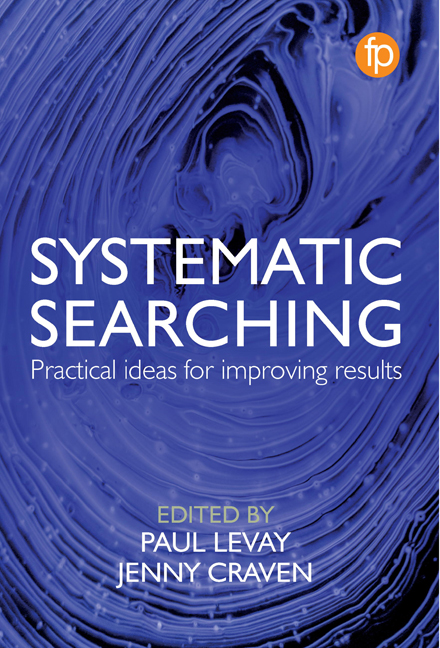Book contents
- Frontmatter
- Contents
- Figures, tables and case studies
- Contributors
- Acknowledgements
- Abbreviations
- Foreword
- 1 Introduction: where are we now?
- 2 Innovative approaches to systematic reviewing
- 3 Searching for broad-based topics
- 4 Choosing the right databases and search techniques
- 5 Gathering evidence from grey literature and unpublished data
- 6 Social media as a source of evidence
- 7 Text mining for information specialists
- 8 Using linked data for evidence synthesis
- 9 Evidence surveillance to keep up to date with new research
- 10 Training the next generation of information specialists
- 11 Collaborative working to improve searching
- 12 Communication for information specialists
- 13 The information specialist as an expert searcher
- 14 Conclusion: where do we go from here?
- Glossary
- Index
14 - Conclusion: where do we go from here?
Published online by Cambridge University Press: 08 June 2019
- Frontmatter
- Contents
- Figures, tables and case studies
- Contributors
- Acknowledgements
- Abbreviations
- Foreword
- 1 Introduction: where are we now?
- 2 Innovative approaches to systematic reviewing
- 3 Searching for broad-based topics
- 4 Choosing the right databases and search techniques
- 5 Gathering evidence from grey literature and unpublished data
- 6 Social media as a source of evidence
- 7 Text mining for information specialists
- 8 Using linked data for evidence synthesis
- 9 Evidence surveillance to keep up to date with new research
- 10 Training the next generation of information specialists
- 11 Collaborative working to improve searching
- 12 Communication for information specialists
- 13 The information specialist as an expert searcher
- 14 Conclusion: where do we go from here?
- Glossary
- Index
Summary
Methods, technology and people
The first part of this book described the developments that are taking place in the methods of systematic searching. The methods have been applied in many subject areas beyond evidence-based medicine. Chapter 2 considered qualitative evidence, realist reviews and mixed methods, while Chapter 5 covered the value of unpublished data and grey literature. Chapter 3 set out some of the techniques that have been applied in broad-based topics, such as in the social sciences, Chapter 4 showed how to choose sources across a range of disciplines and Chapter 6 highlighted the potential to use social media in a range of topics.
Methods have been established in topic areas beyond the scope of this book. One productive area has been environmental management, where techniques and sources are being tested, discussed and applied. There is guidance on doing an ecological synthesis (Bayliss and Beyer, 2015) and systematic searching for environmental evidence (Livoreil et al., 2017) that has assessed the role of grey literature (Haddaway and Bayliss, 2015). There have been similar efforts in the topic area of food and feed safety to understand the types of evidence required (European Food and Safety Authority, 2010) and how it might be systematically identified (Wood et al., 2018). The challenge is to continue developing methods in new directions that are appropriate to the subject and types of evidence that it generates. Information specialists will need to both stay up to date with innovations in evidence synthesis and lead the response in terms of adapting information retrieval practice.
New processes and systems are being built to exploit the full potential of technology. The text mining tools described in Chapter 7 highlighted that it may not be feasible to maintain a clear demarcation between the search and screening process as the information specialist may need to work with results sorted by algorithms, use relevance ranking or help to decide which cut-off points to use. Chapter 8 showed that we may no longer need to think of systematic reviews in terms of whole documents and that it may be fruitful to consider the evidence in more granular terms. Chapter 9 has shown how automation is revolutionising the way evidence is identified across whole subject areas and can be integrated efficiently into reviews using classification systems.
- Type
- Chapter
- Information
- Systematic SearchingPractical ideas for improving results, pp. 289 - 292Publisher: FacetPrint publication year: 2018



